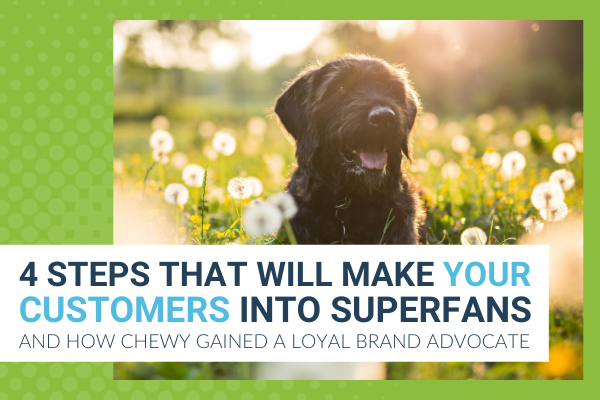This article originally appeared on AdWeek.com on May 17th, 2018.
Every business has the potential to create high-value “superfan” customers, but few take the time to employ the smart tactics necessary to do so.
A “superfan” is a consumer who over-indexes in his or her affinity for a brand, team, entertainer, or property, thereby increasing the chance he or she will advocate on its behalf. Casual fans often stop short of advocacy, spending less money on their customer lifestyle and inspiring fewer prospects to interact with your brand.
Advocacy is key: According to a 2017 study, 19 percent of sales are driven by consumer conversations. That’s a lot of purchasing power — between $7 trillion and $10 trillion annually, to be exact. Consumers are 10 times more likely to make a purchasing decision based on a peer’s suggestion than a celebrity’s.
I’m impressed when a brand is able to take me down the “Path to Superfandom” in a creative, effective way. That’s exactly what Chewy.com did last year. What could have been a one-time purchase has become recurring orders of more than $100 every month. I’ve told dozens of my pet-owning friends about Chewy. My lifetime value as a Chewy customer will be well into five figures, not counting the pass-along value of my referrals.
It Began with a Bear: Affinity

Bear, one of the rescue puppies I adopted, was diagnosed with GI issues and needed prescription dog food (yep, that’s a real thing). I saw that the pricing was identical at every retailer and went to add the food to my Amazon cart. That’s when I vaguely remembered a postcard from Chewy.
I define awareness as sharing your brand’s “why” in a way that resonates with consumers. It’s not as simple as “consumers have heard about my brand”; it’s “consumers have heard about my brand and have some kind of opinion about what it is and how it might fit into their lives.”
In this case, the “why” that resonated was a “$15 off” offer and the promise of free shipping for a $49 purchase. Like many, I’m typically a convenience-then-price shopper. When there’s no affinity in the picture, convenience and price rule the day. It takes a good “why” to affect my default actions.
Influencing Action
The direct mail offer was strong enough to lead me to take action. Customers take many individual actions on the path to superfandom, and reactions and interactionsfrom your brand are key to converting first-time customers into repeat customers.
This particular dog food required a vet’s authorization, which I emailed. Minutes later, on a Sunday, I received a response.

Kelly R (not “Customer Service Team”) refers to my dog by name. The tone immediately gives me insight into the brand: “Give us a bark,” “lend a helping paw,” and “Chow-Chow for now” are fun and memorable. After reading this email, I was well on the path to affinity.
Building Affinity
Affinity is the result of a customer’s expectations consistently being exceeded. Kelly avoided meeting my action with a standard response; she raised the bar again by inviting me to send a photo of my dog.
Not only is this customer service rep not trying to end an otherwise-closed case, but she’s also reminding me she cares about my puppy. When a customer feels affinity toward your brand, she’s more likely to favor your product, service, or experience over others.
The same line of thinking that leads customers to frequent local coffee shops — despite lower-cost or more convenient options existing — is at work here. Many of the items Chewy sells are identical to other pet stores’ offerings, meaning the more it differentiates itself on customer service and brand, the less important it is to compete on price.
Creating Advocacy
Customers on the advocacy rung are compelled to tell others about their experience; you’ve successfully integrated your story into theirs. Your “why” is aligned with their “why.”

A week after my first order, a handwritten note arrived. The next time I ordered, a postcard arrived. At Christmas, my pups received a card. When I’ve called Chewy’s customer service line, the operator asked about my dogs by name.
Any company can (and should!) add these personal touchpoints to its marketing mix. It costs very little to send handwritten notes. It costs nothingto send smart, funny emails instead of boring ones. Keeping anecdotal notes doesn’t add to the cost of your CRM.
Going the extra mile to make your customers feel valued can pay off big. Smart marketing tactics helped Chewy become the largest e-commerce acquisition in history in less than six years. By putting customers first in your marketing efforts, you’ll transform your customer base into a fan base. When your customers become your advocates, they’ll sell your products on their own accord.





